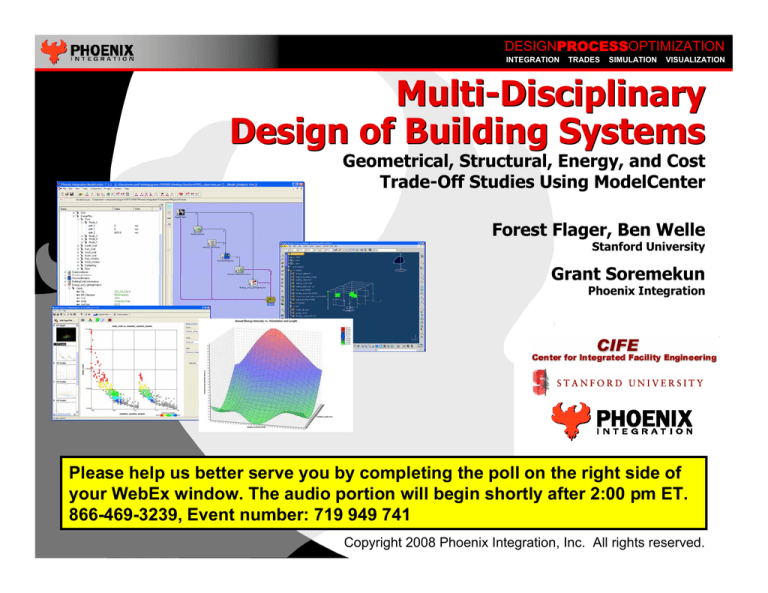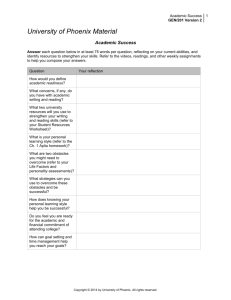
DESIGNPROCESSOPTIMIZATION
INTEGRATION
TRADES
SIMULATION
VISUALIZATION
Multi-Disciplinary
Design of Building Systems
Geometrical, Structural, Energy, and Cost
Trade-Off Studies Using ModelCenter
Forest Flager, Ben Welle
Stanford University
Grant Soremekun
Phoenix Integration
Please help us better serve you by completing the poll on the right side of
your WebEx window. The audio portion will begin shortly after 2:00 pm ET.
www.phoenix-int.com
866-469-3239, Event number: 719 949 741
Copyright 2008 Phoenix Integration, Inc. All rights reserved.
DESIGNPROCESSOPTIMIZATION
INTEGRATION
40 Minute Presentation
• Phoenix Overview
• Stanford/CIFE
TRADES
SIMULATION
VISUALIZATION
Agenda
A copy of this presentation
will be available for download
from the Phoenix website
shortly after the presentation.
Overview
Multi-Disciplinary Design of Buildings
• Case Study: Classroom Design Study
CAD, FEA, Building Code Conformance, and Energy/Lighting Tool
Integration
Cost/Performance Trades
• Future Work / Q&A
Submit questions using the Chat feature
© Copyright 2008 Phoenix Integration, Inc. All Rights Reserved
www.phoenix-int.com
DESIGNPROCESSOPTIMIZATION
INTEGRATION
TRADES
SIMULATION
VISUALIZATION
Background: Phoenix Integration
• 13 year history
• Provide engineering software and
services to customers in aerospace,
defense, and related industries
• Evolved out of a research program at
Virginia Tech
• Office locations
Philadelphia, PA (Corporate)
Blacksburg, VA (R&D)
California (Sales)
North East (Sales)
• World-wide sales in North America,
Europe, and Asia
© Copyright 2008 Phoenix Integration, Inc. All Rights Reserved
www.phoenix-int.com
DESIGNPROCESSOPTIMIZATION
INTEGRATION
TRADES
SIMULATION
VISUALIZATION
Phoenix Value Proposition
1. Improve your decision making
capability
Automate runs of existing tools to
quickly gather information
Apply intelligent algorithms to identify
the best solutions
2. Manage your analysis capability
Knowledge Capture, Search and Reuse
Collaboration and Synchronization
Data Pedigree/Traceability
© Copyright 2008 Phoenix Integration, Inc. All Rights Reserved
www.phoenix-int.com
DESIGNPROCESSOPTIMIZATION
INTEGRATION
TRADES
SIMULATION
VISUALIZATION
Software Automation
• Product Design
• Matlab
• Mathcad
• Excel
• In-house
• CAD
• FEA
• CFD
• Price
• Energy Plus
• ACEIT
• Given design parameters, predicts
performance characteristics:
• Modeling and Simulation
• Flames
• STK
• OpNet
• ProModel
• Arena
• Simulink
• Extend
• Vensim
• Given performance characteristics,
predicts how a system will react to
various stimulus over time
© Copyright 2008 Phoenix Integration, Inc. All Rights Reserved
ModelCenter
www.phoenix-int.com
DESIGNPROCESSOPTIMIZATION
INTEGRATION
TRADES
SIMULATION
VISUALIZATION
Multi-Disciplinary Analysis
ModelCenter - Integrated
Applications Available
Over the Network
Network
ModelCenter
© Copyright 2008 Phoenix Integration, Inc. All Rights Reserved
www.phoenix-int.com
DESIGNPROCESSOPTIMIZATION
INTEGRATION
TRADES
SIMULATION
VISUALIZATION
Multi-Disciplinary Trade Studies
Run
Matrix
Parameter Sweeps, DOE, Monte Carlo,
Optimization, Add your own…
Process
Results
ModelCenter
AoA: Analysis of Alternatives
CAIV: Cost As an Independent Variable
SoS: Systems of Systems
DFSS: Design for Six Sigma
MDO: Multi-Disciplinary Optimization
© Copyright 2008 Phoenix Integration, Inc. All Rights Reserved
www.phoenix-int.com
Introduction to the
Center for Integrated Facility Engineering (CIFE)
An academic research center within the Civil and Environmental
Engineering department at Stanford University:
y
Research focus is on the Virtual Design and Construction (VDC) of Architecture – Engineering – Construction (AEC) projects in collaboration with our industry partners
Overview of CIFE Research Projects
Master Planning
Integrated Concurrent Engineering
Collective Decision Assistance
4D Construction Planning
Design-Fabrication-Integration
Automated Field Instructions
Building Performance Monitoring
Process Integration and Design Optimization (PIDO) in Support of Multidisciplinary Building Design
Research Team:
Forest Flager, Structural Engineer
Benjamin Welle, Mechanical Engineer
Prasun Bansal, Aerospace Engineer
Kranthi Kode, Structural Engineer
Victor Gane, Architect
Industry Collaborators:
Phoenix Integration
Gehry Tehnologies
Supervised By:
Professor John Haymaker
Project Objectives
Overview
The time required for model-based structural
and energy performance analysis feedback means
few (if any) alternatives are evaluated before a decision
is made.
Objective
Develop a platform to integrate CAD and analysis
tools for design exploration and optimization that:
¾ Does not require specialist skills
¾ Provides a robust, flexible and extensible environment
Intuition
Providing designers with this platform will allow them
to explore the design space more efficiently, resulting
in higher performance and cost-effective design solutions.
Proof of Concept Case Study: Classroom
Variables
¾ Building orientation (0)
¾ Building length (L)
¾ Window / wall ratio (W)
¾ Structural steel sections
L
Constraints
¾ Fixed floor area
¾ Structural safety
¾ Thermal comfort
¾ Energy performance
¾ Daylighting performance
Objective
¾ Minimize first cost for structural steel
¾ Minimize annual operating costs for
energy
O
beam
steel frame
girder
column
Multidisciplinary Process Overview Structural Steel Section Optimization Process 2
3
2
3
4
Pin
4
5
Enc
0.16
5000000
4500000
0.14
4000000
0.12
3500000
0.1
3000000
0.08
2500000
2000000
0.06
1500000
0.04
1000000
0.02
500000
0
0
0
5
10
15
20
25
30
Iteration Number
Model Mass
Percentage Over Utilised
35
40
% o f e le m e n ts o v e r u tilis e d
1
M ass
1
Multi‐Disciplinary Analysis Model
ModelCenter
Impact of Steel Section Sizes on Structure Cost
Values for section
types / building
length that yield
best designs
Each line
represents a
single design
Beam Section Type
Cost
Max
DC Ratio
Building
Length
Girder
Sections
Column
Sections
Beam
Sections
Total Cost
Each point
represents a
single design
Impact of Steel Section Sizes on Structure Cost
Optimization Data For Beams, Columns, Girders
~2000 simulations
Hover
Hover over
over any
any design
design
point
to
view
point to view associated
associated
values
values and
and geometry.
geometry.
Beams and Column Size vs. Total Cost
W12x
HSS 4x
W14x
HSS 6x
HSS 8x
Impact of Building Geometry on Structure Cost
Plot Variable: response (Model.class_cost_2.total_cost)
Steel Cost vs. Building Length and Number of Columns
730872
691764
652655
613547
574438
535330
496221
457113
418004
378896
$720,000
$710,000
$700,000
$690,000
$680,000
$670,000
$660,000
$640,000
$630,000
$620,000
$610,000
$600,000
$590,000
$580,000
$570,000
total_cost
total cost of steel structure
$650,000
$560,000
$550,000
$540,000
$530,000
$520,000
$510,000
$500,000
$490,000
$480,000
$470,000
$460,000
$450,000
$440,000
$430,000
$420,000
$410,000
$400,000
$390,000
$380,000
$370,000
20
20.5
21
21.5
22
22.5
23
23.5
24
24.5
25
25.5
26
26.5
27
27.5
28
28.5
29
29.5
30
30.5
31
31.5
32
32.5
33
33.5
34
34.5
3535.5
36
36.5
37
37.5
38
38.5
39
39.5
40
40.5
41
41.542
42.5
43
43.5
44
44.545
45.5
46
46.547
47.5
48
48.549
49.5
5050.5
51
51.552
52.553
53.554
2.8 3
54.5
5555.5
5656.5
5757.5
5858.5
5959.560
bldg_length
building length (L)
3.2 3.4 3.6 3.8 4
9.6
8.6 8.8 9 9.2 9.4
7.6 7.88 8.2 8.4
6.4 6.6 6.8 7 7.2 7.4
5.4 5.6 5.8 6 6.2 num_columns_along_length
4.2 4.4 4.6 4.8 5 5.2
number of columns
along length
Energy and Daylighting Analysis
4 Primary Stages of Data Execution
Step 1: Geometric data is extracted from DP
Step 2: Through a series of steps, an
Energy Plus input file is created
Step3: EP runs energy simulation
Step 4: Output from EP is processed by
Phoenix to determine next geometric
design option based on constraints on
energy consumption, geometry,
daylighting performance, and cost
Impact of Design Variables on Energy Performance
Annual Energy Intensity (MJ/m2)
Annual Energy Intensity vs. Orientation and Length
Least Efficient
¾ Reducing west facing windows
to minimize energy consumption
is a common rule-of-thumb.
¾Our building displayed
seemingly incorrect results.
Length (mm)
Orientation (deg)
Most Efficient
Annual Solar Heat Gain vs. Orientation and Length
¾Visualizations enabled
transparency in the impact
between solar and lighting load
impacts on energy consumption.
Annual Solar Heat Gain
(MJ/m2)
¾ Result: Larger west facing
windows resulted in lower energy
consumption!
Length (mm)
Length (mm)
Orientation (deg)
Orientation (deg)
Optimization vs. DOE Results for
Energy and Daylighting Performance
¾ The correlation between the optimum designs using DOE and the optimizer was extremely
high. Simulation time to achieve optimum designs was reduced by almost 75%.
Total Annual Cost
($/ft2)
Total Annual Cost vs. Orientation and Length
Optimum areas of
design space
Length (mm)
Orientation (deg)
DOE- 416 simulations
Optimization-110 simulations
Next Steps / Future Work
Structural:
¾
Consider alternative structural materials
Mechanical / Energy:
¾
¾
¾
Consider different materials and HVAC equipment
Integrate the lighting engine Radiance for daylighting performance
Integrate a Computational Fluid Dynamics (CFD) simulation engine to optimize space temperature stratification, air speed, and mean radiant temperature
General: ¾
¾
¾
¾
¾
Tradeoffs btw Structural, Energy, and Cost Performance
Make software wrappers more robust / flexible
More complex building types
Integrate architectural analyses
Parallel computing to reduce trade study run times
DESIGNPROCESSOPTIMIZATION
INTEGRATION
TRADES
SIMULATION
VISUALIZATION
Questions and Answers
To submit a question, use the chat feature of WebEx. If we do not
answer a question online, we will be sure to follow up with an e-mail.
Upcoming Schedule:
y May: Automation, Integration, Trade Studies
Forest Flager
forest@stanford.edu
Ben Welle
bwelle@stanford.edu
Grant Soremekun
grant@phoenix-int.com
y June: Fidelity Forward Design: NX/Nastran
Previous Topics*:
y A Fully Integrated Risk and Cost Model for
Complex Aerospace Systems
y Analysis of Alternatives
y Intelligent Decision Making within Large Scale
Simulations
y System of Systems Optimization
webcast@phoenix-int.com
800-500-1936
© Copyright 2008 Phoenix Integration, Inc. All Rights Reserved
* Available for download from:
www.phoenix-int.com





